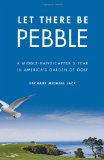There are reasons certain sayings persist. Take, for example, the overused and abused saw, “A picture is worth a thousand words.” It survives because it is true. Some things words just cannot adequately describe: Van Gogh’s “Starry Night” or a tropical island. Even describing the effect such sights have on us is woefully insufficient.
 Applying the adage to Zachary Michael Jack’s Let There Be Pebble: A Middle-Handicapper’s Year in America’s Garden of Golf, you can estimate the book is missing 10,000 to 20,000 words. To explore the mystique and allure of Pebble Beach Golf Links, Jack, a self-described “Pebble Beach virgin,” immersed himself in the culture of the course and neighboring Carmel, California, for a year. Despite reveling in the course and the coastline upon which it is located, the book has an inexplicable flaw: aside from the cover it contains no pictures, maps or even drawings of the golf course or Carmel.
Applying the adage to Zachary Michael Jack’s Let There Be Pebble: A Middle-Handicapper’s Year in America’s Garden of Golf, you can estimate the book is missing 10,000 to 20,000 words. To explore the mystique and allure of Pebble Beach Golf Links, Jack, a self-described “Pebble Beach virgin,” immersed himself in the culture of the course and neighboring Carmel, California, for a year. Despite reveling in the course and the coastline upon which it is located, the book has an inexplicable flaw: aside from the cover it contains no pictures, maps or even drawings of the golf course or Carmel.
Although the book is part personal journey into a golf mecca and part homage to a father who built a greens-less pasture golf course on their Iowa farmstead, it also is aimed at trying to describe the course and how it is viewed by golf professionals, area residents and others. Yet if you are going to detail the course and changes on it over the years, shouldn’t you at least have even a scorecard-like drawing of the layout? Likewise, quoting someone that “the eighth [hole], tee shot at the tenth, the fourteenth, seventeenth and eighteenth are holes that cannot be equaled anywhere,” loses a lot without seeing the holes. The same is true for the repeated references to the necessary second shot over a ravine on the eighth hole. And discussions of the Carmel gate to the golf course and various streets and locations in the town mean less without a small map showing their spatial relationship.
Maybe these were thought unnecessary as the market for Let There Be Pebble are those at least somewhat familiar with the course from personal visits or television. I have had the pleasure of playing Pebble Beach twice in my life (before the advent of $500 green fees) and spent three weeks living a mile or so south of Carmel. Yet even with that familiarity, pictures or maps would have enhanced the book for me. Thus, they would seem almost crucial for someone who hasn’t actually trod that ground.
Granted, this criticism doesn’t go to Jack’s efforts or the substantive content. Once we get past a few too many of the kinds of metaphors that tend to haunt sportswriting, Let There Be Pebble immerses the reader in the history, myths and legends of Pebble Beach. Jack lets us hear firsthand from golfers, local historians, employees and former local reporters — even those with contrarian views — while blending in the written history. (The history includes the following oath taken by golfers on the course’s opening day on Washington’s birthday weekend in February 1919: “”We Pledge Ourselves by Our Faith in the Cherry Tree to Turn In Honest Score Cards.”) In embarking on his total immersion approach, Jack takes two unique, almost surprising, approaches.
First, Jack doesn’t repeatedly play Pebble Beach and regale us with stories of his trials, tribulations and successes. To the contrary, we accompany him only once playing Pebble Beach and as he plays with members of The Shivas Irons Society on nearby Pacific Grove Golf Links. Most of the book is built around Jack, on a sabbatical from the college at which he teaches English, working as a reporter for several tournaments at Pebble Beach, including the 2010 U.S. Open, and living in neighboring Carmel.
The latter gives readers a closer look at Carmel than one might expect in a book about Pebble Beach. Although Clint Eastwood and his wife, Dina, may too often serve as a prism, Jack takes us house hunting and inside city politics and the history of the town and area. As such, this is more complete view of Pebble Beach as archetype and destination than Pebble Beach the golf course. With such an approach, Jack may be treading a fine line between those readers who care only about the course and those who want the broader view of the life and culture of the course and its setting. Still, he should be commended for taking a more expansive perspective — even if he left out the pictures.
It’s an adjective. It’s a verb. It’s a noun. It’s golf.
Zachary Michael Jack, Let There Be Pebble







